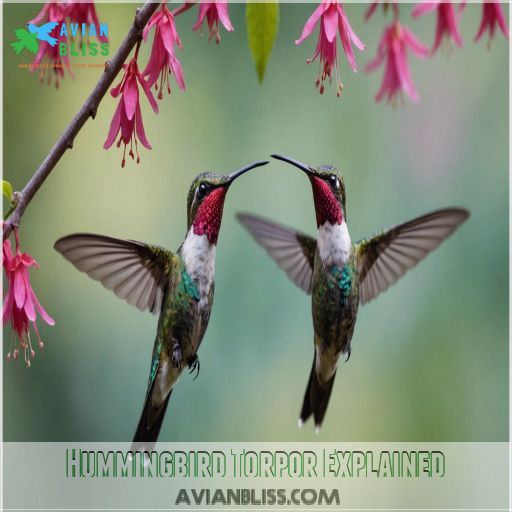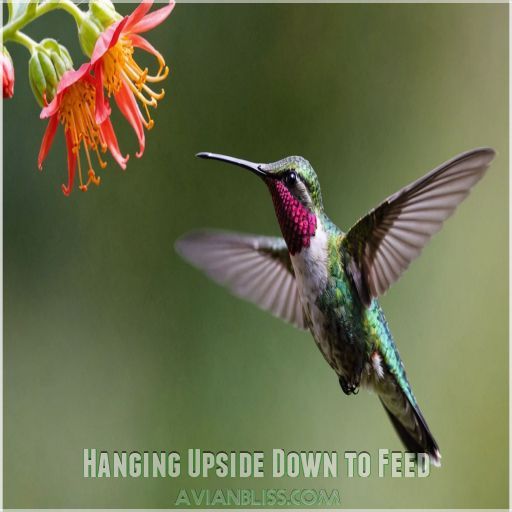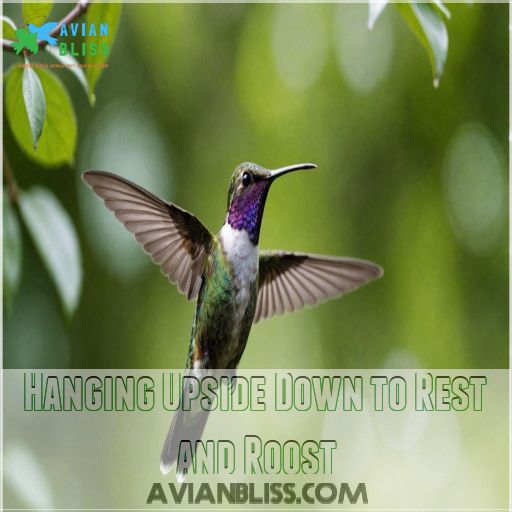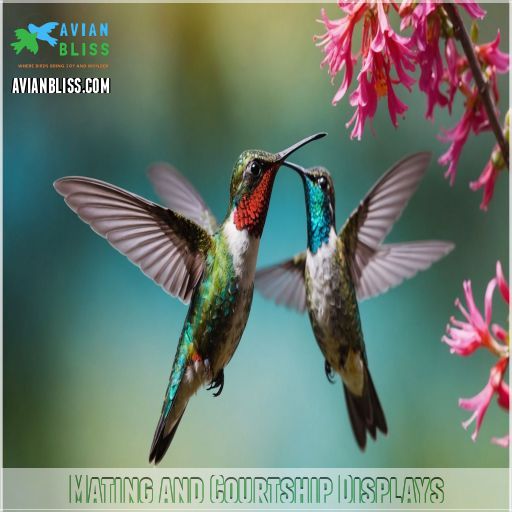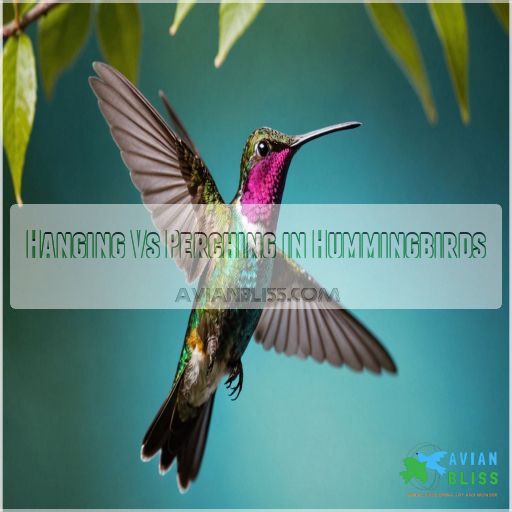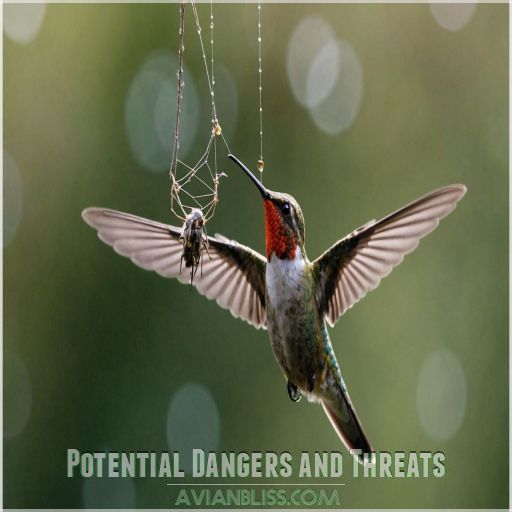This site is supported by our readers. We may earn a commission, at no cost to you, if you purchase through links.
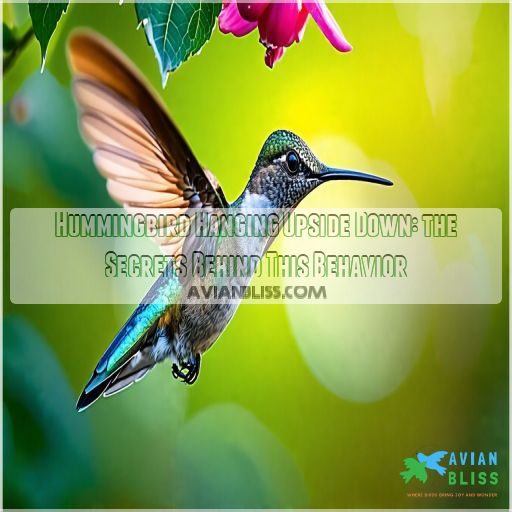
Imagine a tiny, feathery superhero recharging overnight. By slowing their metabolism and breathing, they conserve energy till morning. Sometimes, they even nap in this state during the day!
It’s like saving phone battery by plunging into sleep mode. Fear not; your suspended friend isn’t auditioning for a bat role. Instead, it’s an artful strategy for survival.
Curious about their encore performances and feeding tricks? Stay tuned.
Table Of Contents
- Key Takeaways
- Hummingbird Torpor Explained
- Hummingbird Sleeping Habits
- Hanging Upside Down to Feed
- Hanging Upside Down to Rest and Roost
- Grooming and Thermoregulation
- Mating and Courtship Displays
- Hanging Vs Perching in Hummingbirds
- Energy Conservation and Hanging Behavior
- Potential Dangers and Threats
- Hummingbirds in Captivity
- Frequently Asked Questions (FAQs)
- Do hummingbirds sleep upside down?
- What if a hummingbird hangs upside down from a feeder?
- Why is my hummingbird backwards?
- Why do hummingbirds stay in torpor?
- What does it mean when a hummingbird hangs upside down?
- How can you tell if a hummingbird is in distress?
- What to do if a hummingbird is in torpor?
- How to tell if a hummingbird is alive?
- How do hummingbirds avoid falling while hanging upside down?
- Can hummingbirds sleep while hanging upside down?
- What are the benefits of hanging upside down for hummingbirds?
- How do hummingbirds maintain their balance when changing direction?
- Do all hummingbird species exhibit the same hanging behaviors?
- Conclusion
Key Takeaways
- Hanging upside down isn’t a death-defying stunt for hummingbirds; it’s how they save energy during torpor, slowing down like a phone in power-saving mode.
- Think of a tiny Cirque du Soleil act—hummingbirds hang to access hard-to-reach nectar or catch insects, turning eating and survival into an aerial spectacle.
- Not all heroes wear capes, but male hummingbirds hang upside down to flaunt their colors and impress the ladies, using these acrobatics in their courtship displays.
- Even these high-fliers need a break; hanging upside down helps them rest in unique spots, conserving energy while avoiding predators.
Hummingbird Torpor Explained
When you spot a hummingbird hanging upside down, it’s likely in a state called torpor, a handy survival trick that helps it save energy.
Like a tiny superhero recharging overnight, the hummingbird lowers its metabolism, heart rate, and even body temperature to rest effectively, in a process that can be likened to a tiny superhero recharging overnight.
What is Torpor in Hummingbirds
You may not realize it, but hummingbirds can enter a deep sleep-like state called torpor to conserve precious energy.
During torpor, their metabolism slows by up to 95%, body temperature drops considerably, and heart rate plummets – allowing them to survive surprisingly low temperatures.
This remarkable adaptation is a true marvel of nature.
How Do Hummingbirds Enter Torpor
Hummingbirds, nature’s tiny marvels, enter torpor when they need to conserve energy.
Cooler temperatures trigger this state, dramatically slowing their heart rate and metabolism, sometimes leaving them hanging upside down.
Imagine snoozing as your heartbeat drops, saving energy for the next Gulf of Mexico adventure. Torpor can last just a few hours or an entire night depending on needs.
Exceptions to Nightly Torpor
Artificial light, migration, and food abundance can shake up hummingbirds’ nightly torpor plans.
Imagine this: a hummingbird skips torpor on a warm night. Why? It’s overeaten on nectar!
Here are three exceptions:
- Artificial light impacts natural rhythms.
- Migration demands energy to move.
- Food abundance leads to choices like skipping torpor.
Each bird is a unique story!
Benefits of Torpor for Hummingbirds
Imagine a little hummingbird slowing its metabolism to conserve energy while in torpor.
This nightly routine provides a survival advantage, helping it avoid predators and endure chilly weather.
By reducing their body temperature, they achieve winter survival and energy conservation, ensuring they’re ready for the next day’s hustle for nectar—which is no small feat for these tiny daredevils!
Hummingbird Sleeping Habits
You’ll find hummingbirds doze off in some peculiar spots, often choosing branches or twigs that offer protection from predators.
They prefer cozy, sheltered locations like oak or birch trees, providing an ideal hideout to conserve energy during their nightly rest, specifically to conserve energy.
Where Do Hummingbirds Most Often Sleep
Nestled under a canopy or atop a sturdy branch, hummingbirds choose their sleeping spots with care. They thrive on balancing tension and tranquility.
Here’s what to know:
- Hummingbird sleeping positions: Often hang upside-down during torpor.
- Roosting locations: Perch securely on twigs.
- Shelter preferences: Seek wind-protected spots.
- Branch types: Opt for narrow, inconspicuous ones.
Preferred Sleeping Locations for Hummingbirds
While hummingbirds often sleep where they nest, they can choose various sleeping spots.
They prefer thin, forked branches in trees, safe from predators.
Deciduous trees like oak and sycamore are often best, providing ideal branch sizes for resting.
Look for hummingbirds snoozing on these slender perches, taking a break from their busy, nectar-filled lives.
Importance of Sheltered Locations
To keep those tiny hummingbirds safe, you’ll want to place their feeders near dense, sheltering plants like vines, shrubs, or conifers.
This provides them a quick escape route from predators and a cozy spot to rest between meals.
After all, hummingbirds need to conserve every bit of energy they can , as they have to rest between meals.
Hanging Upside Down to Feed
When you’re watching a hummingbird hang upside down, it’s likely getting a sip of nectar from a hard-to-reach flower or feeder.
This amazing acrobatics helps hummingbirds also snag insects hiding beneath leaves, showing they’re not just pretty faces—they’re clever feeders too, capable of amazing acrobatics.
Accessing Nectar From Obstructed Flowers
When hummingbirds hang upside down, they’re not just clowning around; they’re maximizing feeding efficiency.
Imagine a peculiar flower shape or tricky nectar depth, where using refined white sugar and water for hummingbird nectar, like in hummingbird sugar water recipes, can be just as essential as accessing it.
These challenges are why they’ve developed hanging adaptations to access nectar from otherwise obstructed flowers.
Next time you spot a hummingbird defying gravity, remember, it’s mastering flower accessibility with a touch of aerial acrobatics.
Catching Insects While Hanging Upside Down
Imagine a tiny acrobat hanging upside down, ready to catch its insect prey mid-air.
These hovering hunters employ clever insect-catching tactics, seizing opportunities as insects venture close.
Upside-down feeding allows hummingbirds to snatch tasty morsels efficiently. It’s like a fly-catching circus act—minus the trapeze!
This daring aerial maneuver showcases their adaptability in nature’s grand stage.
Benefits of Hanging Feeders for Hummingbirds
Hanging feeders for hummingbirds can transform your yard into a nectar haven. Imagine this:
- Nectar accessibility becomes a breeze with a thoughtfully designed feeder.
- Enhance hummingbird safety by placing feeders away from predators.
- Careful feeder placement attracts these energetic birds while ensuring they’re not hanging upside down too much for a meal.
Hanging Upside Down to Rest and Roost
When you’re feeling tired, you may think of lying down for a nap, but hummingbirds do things a bit differently.
By hanging upside down, they conserve energy and rest, even taking mini naps to recharge for their next flight.
Conserve Energy by Hanging Upside Down
You’re probably wondering why a hummingbird might hang upside down instead of perching.
It’s all about energy conservation! These tiny birds enter a state called torpor, reducing their heart rate and metabolism to save precious energy when they hang.
With such high energy needs, this quirky behavior is a clever strategy to stay safe and sound.
Mini Naps While Hanging Upside Down
Hummingbirds may surprise you by taking mini naps while hanging upside down.
This unusual behavior helps them conserve precious energy. As their metabolism slows, they can enter a state of torpor, lowering their body temperature and heart rate.
So the next time you spot a hummingbird hanging upside down, don’t worry – it’s just resting up for its next high-speed flight!
Inverted Roosting Position at Night
Spotting a hummingbird hanging upside down at night might seem odd, but it’s just nature’s clever design.
This inverted roosting position saves energy, acting like a built-in battery saver during chilly nights.
It also offers camouflage benefits, protecting them from predator threats.
For these tiny creatures, a good night’s rest sometimes means going topsy-turvy .
Grooming and Thermoregulation
Have you ever seen a hummingbird hanging upside down and wondered why?
This unique position helps them dry off, groom hard-to-reach feathers, and regulate body temperature by fluffing up their plumage.
All while adding a touch of flair to their routine.
Drying Off After Getting Wet
After a nice bath or rain shower, these tiny acrobats sometimes hang upside down to dry off.
It’s like their version of a spin cycle. By hanging, they let water droplets fall, speeding up drying time for wet feathers.
This position also helps with wing drying, ensuring their hummingbird feather care is excellent for efficient flight.
Grooming Feathers While Hanging Upside Down
Imagine a tiny acrobat mid-performance. That’s your hummingbird, hanging upside down to groom its feathers.
This quirky behavior helps with top-notch feather care, especially considering their unique feather maintenance habits, like preening with oil from their oil glands to keep their feathers in top shape for flight learn more about hummingbird feather maintenance. By doing this, they apply a waterproof layer that keeps their feathers aligned and ready for flight, making their upside-down grooming routine even more effective.
Consider:
- Feather preening helps with hygiene and flight.
- Upside-down grooming offers gravity’s assistance.
- Hanging grooming might help access harder-to-reach spots.
- It could also scare off competitors with fancy moves.
Nature’s little clean freaks, no doubt!
Thermoregulation by Fluffing Plumage
When you see a hummingbird puff up like a mini feathered balloon, it’s tackling temperature control head-on.
Their feathers fan out, creating an air pocket shield, essential for heat regulation and winter survival.
It’s like having your own cozy duvet during chilly nights—cute, right?
Mating and Courtship Displays
In the realm of romance, male hummingbirds have their own acrobatic flair.
Hanging upside down to woo potential mates is more than just a balancing act; it’s how these tiny Casanovas catch the attention of females.
Their courtship displays varying uniquely across different species is what makes their quirky spectacle truly remarkable.
Male Hummingbirds Hanging Upside Down
You may have noticed male hummingbirds hanging upside down at your backyard feeder. This isn’t just for fun – it’s part of their elaborate courtship displays, which include aerial acrobatics like dives.
By hanging inverted, the males can better showcase their colorful plumage and perform acrobatic moves to impress potential mates, highlighting their agility and prowess in mid-air.
These dazzling displays are essential for defending territory and attracting females.
Displaying for Females While Hanging
Hanging from a branch, a male hummingbird performs an elaborate courtship dance to woo his female counterpart.
His hanging posture and aerial displays aren’t just for show—they’re part of mating rituals aimed at catching her eye.
Here, female choice plays a role, as she decides which suitor’s display best charms her heart.
Courtship Display Variations Across Species
Imagine yourself in a rainforest, watching hummingbirds performing acrobatic displays to impress potential mates.
These lively birds compete with courtship dances and vocalizations that vary widely across species.
Some flaunt their feathers like dazzling costumes, while others might focus on nest building or territorial defense.
Each species adds its unique twist, making courtship an enthralling and essential spectacle .
Hanging Vs Perching in Hummingbirds
When comparing the hanging and perching habits of hummingbirds, you’ll find that their preferences can vary by species.
While the ruby-throated hummingbird often perches on branches, the violet-crowned hummingbird likes to hang upside down, offering a unique twist on their nightly rest.
Species-Specific Preferences
Male hummingbirds often display courtship feats, but did you know some species like the Violet-Crowned prefer hanging upside down to perching? This quirky choice reflects species-specific preferences.
While hanging, they conserve energy or catch insects mid-air—a bit like an aerial yoga for birds.
In fact, understanding the unique behaviors of hummingbirds can be enhanced by reading the best books about these birds, such as those that offer Hummingbird Behavior Insights. Such distinct behaviors make each species unique and fascinating.
Ruby-Throated Hummingbird Perching Habits
You’ve learned about species-specific preferences; now, let’s explore Ruby-Throated Hummingbird perching habits.
These birds exhibit selective perch preferences, choosing branches that offer predator avoidance and nest proximity.
Seasonal changes also affect branch selection, as they seek ideal spots for quick escapes.
While small, they enjoy the freedom of a well-chosen perch—like the rest of us with our favorite hangouts.
Violet-Crowned Hummingbird Hanging Habits
While the Ruby-throated hummingbird prefers perching, the Violet-crowned hummingbird has unique hanging habits.
This behavior is linked to energy conservation and predator avoidance.
Hanging more often during courtship displays or when resting, these little acrobats seem to dance on air.
Just imagine a tiny superhero, cape flapping, conserving every ounce of energy for its next flight! (Source)
Energy Conservation and Hanging Behavior
You might be surprised to learn that hummingbirds hang upside down to conserve their precious energy.
By altering their breathing patterns, these tiny birds can minimize energy expenditure while feeding and resting.
A key adaptation for their high-speed lifestyles is this ability to conserve energy.
The strategy helps conserve their precious energy, which is essential for their survival.
High Metabolism and Energy Needs
Hummingbirds are nature’s little sugar addicts, needing constant refueling due to their high metabolism. They burn energy faster than a speeding bullet to maintain flight efficiency. Similar to birds regulating their body temperature, hummingbirds have a rapid metabolism that generates warmth and maintains a body temperature around 105F, nearly 20 degrees warmer than humans.
To conserve energy, they utilize a unique form of thermoregulation, such as countercurrent heat exchange systems, which is particularly effective in regulating blood flow to minimize heat loss. To conserve energy, they hang upside down and enter torpor at night, reducing body temperature.
Mitigating seasonal variations in nectar consumption, they cleverly adapt to changing food sources.
- High metabolism demands constant energy.
- Torpor reduces energy needs.
- Flight efficiency requires frequent feeding.
- Seasonal changes affect nectar availability.
Conserving Energy While Feeding
Imagine sipping nectar while defying gravity. As a hummingbird, you conserve energy by hanging upside down, reducing the strain of constant hovering. This clever trick boosts flight efficiency and maximizes nectar intake, critical when food availability dips.
Plus, with a metabolism faster than a caffeine-fueled racecar, every bit of energy conservation counts!
| Behavior | Benefits |
|---|---|
| Hanging Upside Down | Conserves energy |
| Hovering Less | Saves flight energy |
Breathing Patterns for Energy Conservation
As hummingbirds cleverly conserve energy while feeding, their breathing patterns play a large role in efficiency.
By optimizing oxygen intake, they support high metabolic rates needed for hovering dynamics.
Breathing adaptations support flight efficiency, reducing energy waste.
It’s like a perfectly balanced dance, where every inhale keeps them airborne with minimal effort, leaving us in awe of nature’s tiny aerobatic marvels.
Potential Dangers and Threats
When hummingbirds hang upside down, they’re particularly vulnerable to predators like cats and larger birds that see them as easy prey.
Besides facing threats from predators, they also struggle with habitat loss and severe weather, which can reduce their food sources and impact this energy-saving behavior.
Predators and Hanging Hummingbirds
Despite being swift and agile, hanging hummingbirds face potential dangers.
Praying mantises, with their cunning predator adaptations, can ambush these birds at feeders, using their pincers to catch them unaware.
Meanwhile, snakes also pose a threat by stealthily approaching hanging birds.
To boost survival rates, consider placing feeders strategically, away from lurking predators, ensuring defensive strategies like camouflage remain effective.
Habitat Loss and Food Source Impact
Many factors impact hummingbirds, posing potential dangers.
Consider:
- Nectar plant decline: With fewer flowers due to habitat loss, you might see less hummingbird activity.
- Urbanization impact: Buildings and roads disrupt hummingbird habitats, reducing their safe spaces.
- Pesticide effects: Chemicals in gardens can harm their delicate systems, making survival tougher.
Keep these in mind for their bright future!
Severe Weather Conditions and Hanging Behavior
Severe weather can pose serious threats to hummingbirds.
When temperatures plummet or storms rage, these tiny birds may hang upside down to conserve precious energy.
Without adequate food or shelter, they can quickly become exhausted, putting them at risk of predators or even death.
Stay vigilant and contact a wildlife rehabilitator if you spot a distressed hummingbird.
Hummingbirds in Captivity
You might think keeping a hummingbird as a pet sounds fun, but these tiny creatures just don’t thrive in captivity.
They need lots of space and a special nectar-rich diet, making it tough to meet their needs in a confined environment.
Challenges of Recreating Natural Environments
Capturing the magic of hummingbirds in captivity can be as tricky as juggling hummingbirds. Challenges arise from balancing food sources, habitat size, and climate control. You’ll also need keen social interaction and predator control to keep these tiny acrobats happy.
- Food sources: Mimic their natural diet to provide nourishment.
- Habitat size: Allow ample space for flights of fancy.
- Climate control: Maintain their ideal living conditions.
Dietary Needs and Large Territory Requirements
In captivity, hummingbirds need variety in food. They require nectar sources and insects like spiders and mosquitoes for protein. Unfortunately, mimicking their natural habitat is tough.
These tiny acrobats also crave large territories to support their rapid feeding behavior. Imagine them as tiny superheroes needing space to zoom!
| Dietary Needs | Habitat Loss | Territory Size |
|---|---|---|
| Nectar, insects | Always essential | Large spaces |
| Protein-rich | Limiting factor | Essential for health |
Why Hummingbirds Fare Better in the Wild
Imagine trying to replicate a hummingbird’s expansive territory in your backyard.
You’d need an endless supply of wild food sources, migration routes, and safe nesting conditions—it’s quite the juggling act!
In the wild, they thrive by skillfully maneuvering between natural predators and abundant nectar-rich flowers, ensuring their survival in ways captivity simply can’t match (Source).
Frequently Asked Questions (FAQs)
Do hummingbirds sleep upside down?
Hummingbirds don’t typically sleep upside down.
They sometimes do when entering torpor, a deep sleep-like state.
Their metabolic rate slows, conserving energy.
If their perch is slick, they might slip into this head-down position.
What if a hummingbird hangs upside down from a feeder?
Picture a tiny acrobat hanging mid-air.
If a hummingbird hangs upside down, it might be in torpor, a mini-hibernation to conserve energy.
It’s normal, so just let nature take its course.
Why is my hummingbird backwards?
Your hummingbird is probably in torpor, a deep sleep state to conserve energy.
During torpor, it may hang upside down from a perch due to relaxed muscles, which is perfectly normal and temporary.
Why do hummingbirds stay in torpor?
To conserve energy during cold nights, hummingbirds enter a hibernation-like state called torpor.
This reduces their metabolism by up to 95%, allowing them to survive without constant feeding.
It’s an amazing survival strategy in chilly weather.
What does it mean when a hummingbird hangs upside down?
Much like a resting bat, a hummingbird hanging upside down often enters torpor, a hibernation-like sleep, to conserve energy.
Their feet naturally grip, and they’ll awaken refreshed, ready to zip around for nectar.
How can you tell if a hummingbird is in distress?
You can tell a hummingbird is in distress if it displays behaviors like prolonged perching, difficulty flying, or visible injuries.
Look for signs such as discharge, lethargy, or sticking to a feeder.
What to do if a hummingbird is in torpor?
Don’t panic if you spot a motionless hummingbird – it’s likely in a state of torpor, conserving energy.
Leave it be, and it’ll likely awaken on its own within an hour as conditions improve.
How to tell if a hummingbird is alive?
Check if a hummingbird is alive by observing its eyes and breathing. Slight movements or open eyes often indicate life.
If it doesn’t react, gently cup your hands around it to raise it slowly (Source).
How do hummingbirds avoid falling while hanging upside down?
Hummingbirds avoid falling when hanging upside down by locking their toes.
This automatic response helps them grip tightly without conscious effort, even when sleeping or unconscious.
Much like how we clutch our couch remote.
Can hummingbirds sleep while hanging upside down?
Yes, hummingbirds can sleep upside down.
They enter a deep sleep called torpor, which conserves energy.
During torpor, their feet grip perches automatically, but occasionally they slip and hang upside down.
What are the benefits of hanging upside down for hummingbirds?
Hanging upside down helps hummingbirds conserve energy by entering torpor, a state where their metabolism slows and body functions reduce like how they do when they sleep
.
This state allows them to survive cold temperatures and save energy for their high-speed flight needs.
How do hummingbirds maintain their balance when changing direction?
Imagine a tiny acrobat; hummingbirds zip through the air by using their tail feathers for balance and agility.
This flexible tail acts like a rudder, allowing quick direction changes, turning them into aerial ballet dancers.
Do all hummingbird species exhibit the same hanging behaviors?
While some hummingbird species may occasionally hang upside-down, it’s not a behavior exhibited by all.
This quirky pose is often linked to their need to conserve energy during periods of torpor or rest.
Conclusion
Imagine the hummingbird as the ultimate gymnast, gracefully balancing while hanging upside down.
These tiny aerial artists use this behavior for survival during torpor but also to access food, conserve energy, and engage in courtship displays.
By mastering the art of energy conservation, the hummingbird hanging upside down showcases an incredible adaptation.
As you marvel at this versatile creature, remember how diverse and fascinating their world truly is—and how much more there’s to learn and appreciate.

